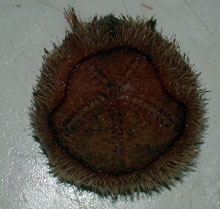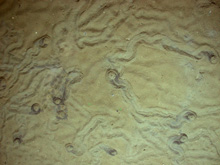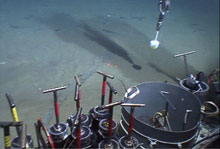This heart urchin was carefully collected at the Atwater Valley 340 site, using the remotely operated vehicle Jason manipulator arm. This specimen will be sent to taxonomists for species identification. Click image for larger view and image credit.
Just one of more than 175 digital still images that Stephanie Lessard-Pilon "stitched" together to create a single large composite image of a heart urchin community. Click image for larger view and image credit.
Scouring the Bottom
June 21, 2007
Stephanie Lessard-Pilon
Penn State University
27° 38.66 N
88° 21.78 W
![]() Besides tubeworm, mussel, and coral communities, scientists have also found sea urchin fields. (Quicktime, 1.3 Mb.)
Besides tubeworm, mussel, and coral communities, scientists have also found sea urchin fields. (Quicktime, 1.3 Mb.)
During last year’s cruise, we were surprised to discover a completely different hydrocarbon seep community type: heart urchins. Part of this year’s cruise has been dedicated to learning more about this new community.
Heart urchins live in and burrow through soft mud, often leaving dark sinuous trails of disturbed sediment behind them. This movement has both physical and chemical effects: the urchins physically mix up the sediment, and the act of disturbing the mud (bioturbation) allows oxygen to reach deeper depths and releases chemicals present in the sediment into the water. These urchins are non-discriminating bottom feeders, and it’s possible that their movement is due to their search for food.
Previous laboratory studies on shallow-water heart urchins have shown that they have a strong effect on the distribution and abundance of meiofauna (animals smaller than one millimeter). Very few studies have looked at the effect of heart urchins on meiofauna in their natural habitat. Over the past year, we’ve been considering how best to determine if changes in meiofauna communities are the result of the physical disturbance caused by the movement of the urchin through the sediment, or if the urchins are actually feeding on the meiofauna.
Though certainly not the most advanced piece of technology used during this cruise, the artificial urchin we fashioned from a toilet-bowl brush and called the "Klobürste" may be one of the most creative uses of a household item for science. By comparing natural and artificial heart urchin trails, scientists hope to learn more about how recently discovered heart urchins affect their community. Click image for larger view and image credit.
We had an excellent opportunity to examine these ideas with the deep-sea heart urchin communities at Atwater Valley 340 (AT 340). During our first visit to AT 340 at the beginning of the cruise, we took a series of sediment cores in urchin trails, in front of urchins, and underneath urchins. These cores will provide information about the natural distribution of meiofauna in urchin trails, and how meiofauna communities differ among trails and undisturbed sediment. After coring, we moved to an undisturbed sea-urchin community and photographed a series of overlapping images with the downward-looking digital still camera. These 175 images were photomosaicked into a single large image of the community. The next step was to test whether the predation or the bioturbation of urchins causes a change in meiofauna communities. To do this, we used an “artificial urchin” (a toilet brush with a T-handle, nicknamed the Klobürste). Using the artificial urchin, Jason pilot Will Handley carefully drew lines in the sediment to the approximate depth of a real sea urchin, mimicking the urchin's motion but not potential predation.
Today we came back and re-photomosaicked the site to see how much, if any, the sea urchins had moved while we were away. We then took a series of sediment cores from inside and outside the artificial urchin trails. With these cores, we’ll be able to compare the meiofauna communities we find in real urchin trails to the sediment we disturbed with the Klobürste. This information will help us determine the relative importance of predation and bioturbation on meiofauna in deep sea urchin fields!


































